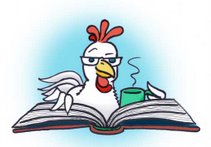And to my surprise, the name that seems to match this chicken wasn't attached to a particular literary figure; it just felt right.
So, herewith, I introduce to you the official book, book, book mascot, hereafter to be known as... Myrtle Jane Chicken, Literary Maven.
"Myrtle" was Susan's suggestion, so she wins the prize! Susan, send me your street address and I'll pop Father's Arcane Daughter in the mail to you.
By rights, Liz deserves a prize too, for contributing the felicitous phrase "Book Maven" which I altered only slightly. I just have one copy of the book, but Liz, if you email me your address too I will gladly send an alternative.
"Jane" is my own addition, to weight down the name and in honor of Chicken Jane, a character in the PBS TV show "Between the Lions". But as no one from PBS actually entered this contest, they don't get any prize.
I have to admit that as a longtime Muppet Show fan I was sorely tempted by the name "Camilla," after Gonzo's longtime hennish love, when I read it in Little Willow's list of literary and pop culture poultry characters, but in the end Myrtle was a Myrtle and that was that. She is a kindly chicken but will brook no waffling.
For your reading enjoyment, here is the complete list of entries, with participants' names and entries' literary antecedents:
*********************
*From Kathy:
Henrietta (SuperChicken)
Babs (Chicken Sisters)
*From Genevieve:
Minerva Louise (Stoeke stories)
Henrietta (
Pouletter (
Lottie (Mathers books)
Rosie (Rosie’s Walk)
Chicken Little
Chicken to the Rescue!
Hen (Little Bear)
*From Anonymous:
Billina (Oz books)
*From Liz:
Henny Penny
*from Alkelda the Gleeful:
Maxine Synecdoche
*From Zeelibrarian:
Desdemona
Ophelia (Hamlet (I love that farmyard Shakespeare idea!)
Marjorie
Babs (Chicken Run)
Ginger (Chicken Run)
*From Liz again:
Hazel Hen, book maven
Ms. Hazel Hen, Research Librarian to the Stars
*From Susan (who claimed to have "nothing to add," which just goes to show you)
MarianMyrtle
*From Tricia:
Poulet Bibliophile
*From Little
Bawk Bawk Book
Poultry in Motion
Book Chick
*Also from Little Willow, a long literary list from Wikipedia, including:
Camilla
*From cloudscome:
Ms. Pecknote
*From Vardibidian:
Darles Chickens
Hen Carey Thomas
Henny Dreadful
Information Hen (Between the Lions)
Helena Henway
*From Slim and Slam:
Helen
Helen the Chicken
*From web:
Queequeg
*From Barbara Bietz:
BibliOphelia
*From HipWriterMama:
Library Chick
Ms. Chickels Peckaway
*From anonymous:
Chicken Little(rary)
*************Many squawks of thanks to everyone who entered! I'm honored to peck around in the yard with such a creative and well-read flock.
